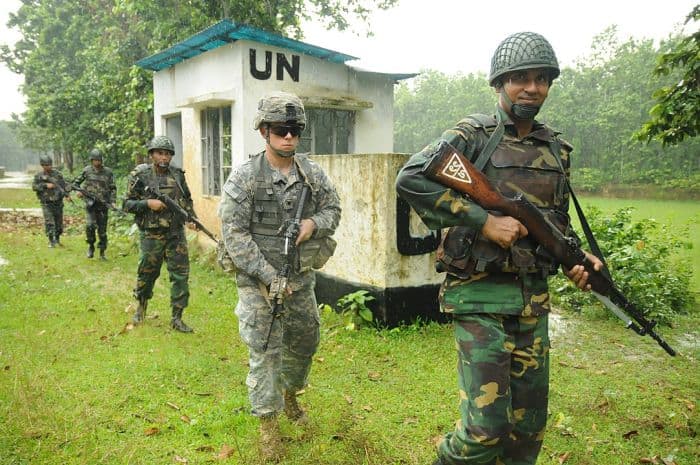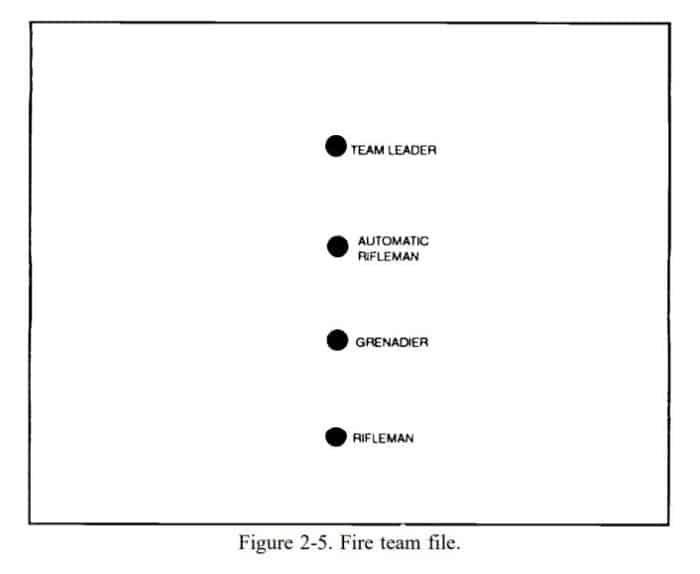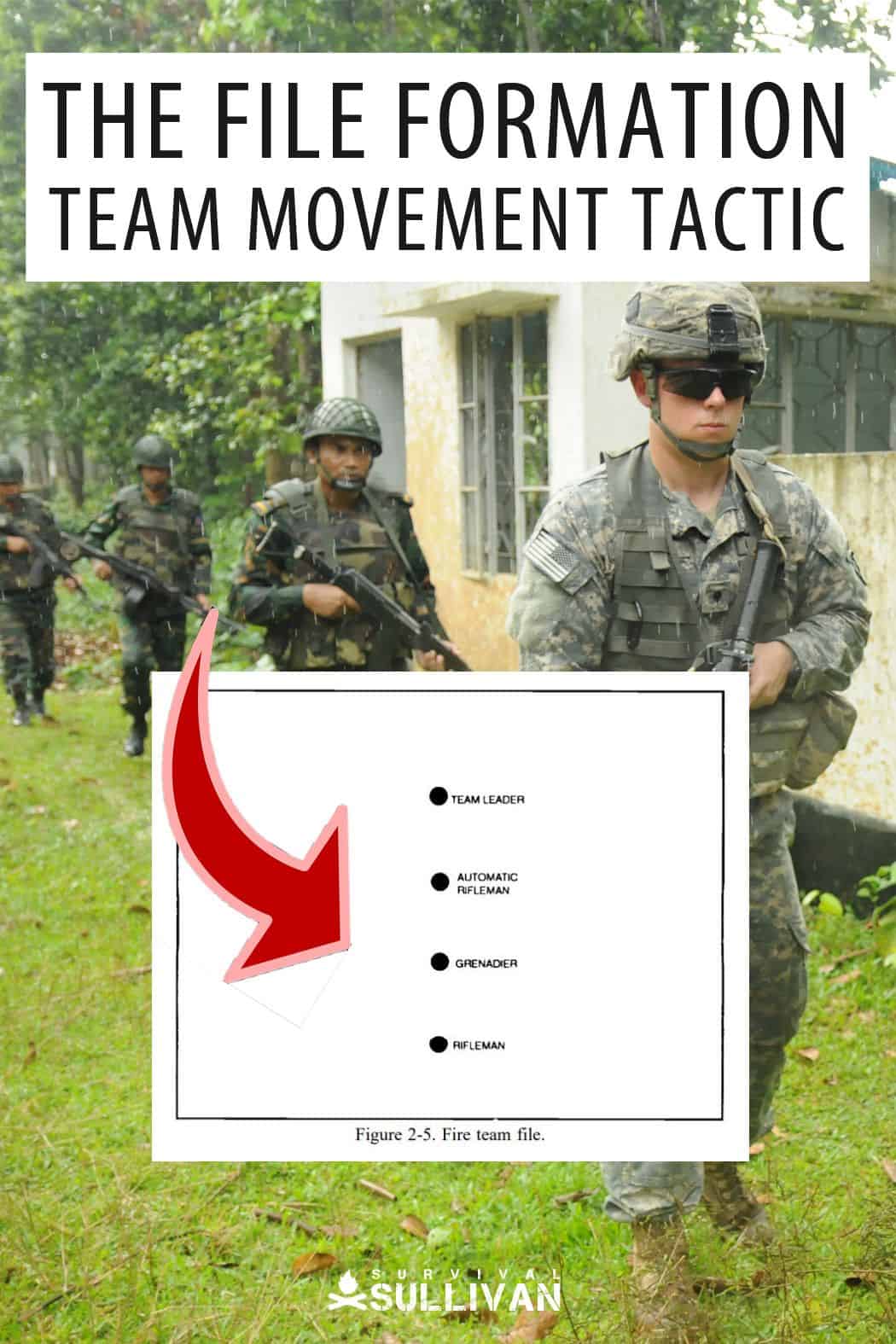Preppers might have it in their minds that they will survive a societal collapse as part of a group of like-minded, similarly trained, and similarly equipped individuals, be they family or friends, but not too many have actually taken the essential step of training and practicing with their erstwhile teammates in proper team tactics and procedures.

It is those same tactics and procedures that will turn a group of individuals with the same objective into an actual team, something worth far more than the sum of its parts.
This is another entry and our continuing series on team tactics for preppers. Within the confines of this series, we will be examining in detail procedures, tactics, and other tips that preppers should consider employing in their own teams to maximize their chances of survival no matter what kind of situation and what kind of threat they are facing.
This entry will cover the file formation, sometimes referred to as a single file or column.
Though this series will doubtlessly be familiar to many in the military with a combat arms background and even some law enforcement personnel, the vast majority of civilians lacking such experience will have little basis for understanding, but much need for that understanding when the chips are down.
This is information that almost any prepper who counts group survival among their plans can use. Continue reading to learn more.

File Formation Essentials
As mentioned previously, if this subject is new or largely unknown to you you’re probably going to run into some vernacular and references that don’t quite click.
If that is the case, feel free to check out my first entry in this ongoing series on team tactics for preppers that cover on-foot movement. That will get you started and everything contained in this and other articles will make a lot more sense.
Considering what we already know about formations, at first glance the file formation does not seem to have much to commend it, especially when you view it through the lens of security and common sense. It is just a line of guys marching in single file, literal ducks in a row!
We all learned this back in grade school for Pete’s sake! How could such a simple formation have anything to recommend it for actual usage in the middle of a situation that might entail life-or-death consequences?
Slow your roll there, reader, as there is more to a formation and team movement than security (although security is an ever-present need).
Also consider that you might not be working with individuals who are switched-on, as competent, and as confident as you are. You could be working in a mixed team of seasoned ass-kickers with good fieldcraft among bumbling duffers, who are nonetheless on your side and have a job to do.
This is one such example where the file formation makes sense. I will expand on this in a minute.
Consider also that any team moving on foot must be dependably controlled. Somebody has to be in control of the team when underway, no matter what.
The file formation is extremely easy to control, and extremely easy to maintain across any terrain and in any conditions on a borderline instinctive level. This is another merit for it when working with the inexperienced.
Lastly, a team might have an overriding need to go fast, as fast as possible. When it is time to make headway you need to streamline and simplify the formation to enable this no matter what sort of terrain and what other conditions you are dealing with.
The single-file formation will allow the team to go as fast as the slowest member can no matter the ground and no matter the route. Sometimes that is the key absolute.
As we will learn in the next section the file formation has plenty to recommend it and it does excel in certain situations, just like any other formation.
More than other formations, however, it is sort of “all or nothing”; it either works very well for the purpose or is going to set you up for disaster with little in between. It isn’t the right answer to every question, but then again no formation is. Keep reading and we will get into the nitty-gritty.
File Formation Details
The file formation is so simple of an arrangement, I can hardly write about it, because you are probably already picturing it, correctly, in your head. The file, or column, formation consists of you and your team walking in a line. A straight line. That’s all.
Each member of the formation should be directly or nearly directly in line with the member ahead of him while maintaining correct spacing.
Spacing is now as always dictated by terrain and visibility requirements, but generally should never be closer than 10 meters. 20 meters is a decent default, but wide open terrain might see this spacing interval increase to 50 meters or even beyond.
Spacing is always crucial for correct employment of formations in all circumstances, but especially critical when using the file formation because an attack from directly ahead or directly behind will gravely imperil team members.
Spacing might be the only thing that saves the team from mass casualties in a sudden attack like that.
The team leader should walk at the head of the formation, or if not right at the head then immediately behind the pointman in front, enabling him to direct the pointman and periodically check on the remainder of the team who should have an easy time following the TL.
As always, the team will look to the team leader’s actions in order to inform their own. They should duplicate the TL’s pace, where the team leader steps, and what stance the team leader has adopted.
If the team leader picks up the pace so does the rest of the team. It’s a team leader crouches or goes prone so does the team.
It is this easy and effective control that makes the file formation so suitable for use with a team of mixed skill levels, since those of lesser skill can be positioned appropriately so that they will always be able to imitate the actions of the more experienced members.
When it comes to security and defense, the file formation is all or nothing. It is very difficult to bring meaningful amounts of firepower to bear directly in front of or directly behind the formation.
However, virtually every gun on the team can easily be brought to bear to the left or right, making the file formation a good choice if contact is expected perpendicular to the team’s path of movement.
Only the lead member of the team in the very front watches the 180-degree arc directly ahead of the formation; every member thereafter should cover the 180 directly to the left, or directly to the right of the formation.
Note that the last man, or trailing element, of the team need not walk backwards as that will make it too easy to trip and fall or lose track of their position in the team; rear security can be provided by periodically turning around and scanning 180 degrees to the rear or 90 degrees backwards to either side before checking the opposite angle.
Pros and Cons
A thorough understanding of the advantages and disadvantages of the file formation is essential for correct employment. Compared to other formations which could afford you some wiggle room as far as best practices, incorrect employment of the file formation can easily lead to disaster.
Pro – The file formation is fast. When it is time to make tracks, the file formation will enable your team to go as quickly as circumstances and fitness permit. No other formation even comes close.
Pro – This formation affords all team members excellent security and the ability to fire to either flank. Even team members that have an area of responsibility opposite the side that the attack originates on need only make a single 90-degree turn to bring their weapon to bear with virtually no concern for hitting other team members.
Pro – The file formation is very easy to control and very easy to maintain. Members need only follow the man in front of them to maintain cohesion and only need to imitate the man in front of them in order to adopt the necessary tactical posture dictated by the team leader.
This affords the team leader excellent control of his team without having to check behind himself constantly.
Con – The file formation is extremely vulnerable to attack from directly in front or directly behind, especially when spacing is getting tight.
An enemy that is perfectly positioned with a weapon capable of producing a large volume of fire, or multiple enemies in the same position can spew out so much lead that they will essentially scythe through the formation like wheat in a field.
It is for this reason that spacing is so essential to success with a file formation compared to others.
Con – The file formation suffers from a distinct lack of capability to bring weapons to bear directly to the front or rear without team members significantly endangering their fellows.
It cannot be overstated how perilous it is for team members in a formation to just open up as soon as they have a sight line without any regard for where their mates might move.
Reacting to a threat directly in front or directly behind in a meaningful way is challenging, to say the least, when using this formation.
Conclusion
The file formation is one that does some things very well, better than most other formations, but it comes with some equally severe drawbacks.
When you need to move fast, make life easy on the team leader, or make life easy on inexperienced team members the file formation is one of the best going.
But do be warned that this formation is highly vulnerable to attack from directly in front or behind, and that counts double when spacing between team members is tight.
On the other hand, a threat that pops up to the left or right of the formation will quickly be obliterated since bringing all weapons to bear on either side is very simple.


Charles Yor is an advocate of low-profile preparation, readiness as a virtue and avoiding trouble before it starts. He has enjoyed a long career in personal security implementation throughout the lower 48 of the United States.
